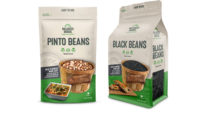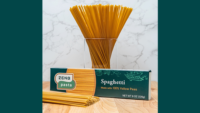Pulses: Beans to Peas
To encourage the further consumption of pulses throughout North America, the Saskatchewan Pulse Growers (SPG) organized a two-day media tour to educate food writers. SPG provides leadership for the Saskatchewan pulse industry, through research, market development and communication.
Saskatchewan is the heart of Canadaís pulse industry, responsible for 99, 80 and 99% of the lentil, pea and chickpea crops, respectively. The Canadian pulse industry has experienced dramatic growth in the past few decades. Production increased from 889,000 tons in 1991 to 4,815,000 tons in 2008, with 60% being exported to India, China, Bangladesh, the U.S. and Colombia.
Pulses are an incredibly nutrient-dense, whole food. Pulses (on average) are considered an excellent source of folate and thiamine (=20% of recommended daily intake (RDI)/serving); a good source of pyridoxine (10-19% of RDI/serving); and a source of riboflavin and niacin (=5% of RDI/serving). They contain several minerals, including potassium, calcium, magnesium, copper, iron and zinc
The overall low lipid content of pulses is particularly important, in light of dietary recommendations to lower fat to reduce the risk for chronic disease. Pulses are an excellent source of high-quality protein, containing approximately 20-25% dry weight, and of dietary fiber (approximately 3-7%), of which approximately 30-40% is soluble
Studies in both animals and humans consistently demonstrate favorable effects of pulses on plasma lipid concentrations. A recent meta-analysis of 10 trials including 268 participants reported reductions in total and low-density lipoprotein cholesterol of 11.8mg/dL (-16.1 to -7.5) and 8.0mg/dL (-11.4 to -4.6), respectively. The benefits of pulses in lowering several indices of cardiovascular disease are most likely due to the combined effects of soluble fiber, vegetable protein and folate, as well as phytochemicals, such as oligosaccharides, isoflavones and saponins
Pulses possess a low glycemic index (GI): lentils and kidney beans at 27, chickpeas at 33 and split peas at 48
Consuming pea fiber significantly decreased insulin resistance by up to 18%, compared to control, and resulted in a shift in the android-to-gynoid fat ratio, suggesting pulses help reduce obesity in the abdominal area. Further, eating 1 cup of pulses 5 days/week for 8 weeks improved long-term blood sugar control, reduced the amount of calories eaten and decreased the waist size of 44 overweight and obese study subjects
Along with this excellent science, there is a continued interest on the part of food companies in using pulses. For example, there were nearly 160 product launches containing pea protein in 2009, according to Mintel figures, in comparison to fewer than 10 products in 2000. Pulses can be easily incorporated into a variety of food products to provide both health attributes and functionality. NS
For more information:
Saskatchewan Pulse Growers * Saskatoon, Saskatchewan
Rachael Kehrig * Rachael.kehrig@saskpulse.com
www.saskpulse.com
Pulse Canada * Winnipeg, Manitoba
Tracey Thompson * tthompson@pulsecanada.com
www.pulsecanada.com
References:
Looking for a reprint of this article?
From high-res PDFs to custom plaques, order your copy today!





